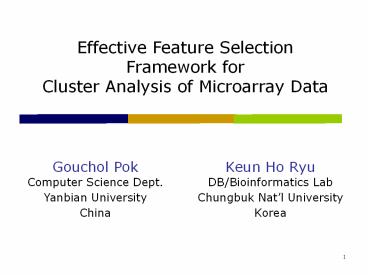Effective Feature Selection Framework for Cluster Analysis of Microarray Data - PowerPoint PPT Presentation
Title:
Effective Feature Selection Framework for Cluster Analysis of Microarray Data
Description:
Effective Feature Selection Framework for Cluster Analysis of Microarray Data Gouchol Pok Computer Science Dept. Yanbian University China Keun Ho Ryu – PowerPoint PPT presentation
Number of Views:241
Avg rating:3.0/5.0
Title: Effective Feature Selection Framework for Cluster Analysis of Microarray Data
1
Effective Feature Selection Framework for
Cluster Analysis of Microarray Data
- Gouchol Pok
- Computer Science Dept.
- Yanbian University
- China
Keun Ho Ryu DB/Bioinformatics Lab Chungbuk Natl
University Korea
2
Outline
- Background
- Motivation
- Proposed Method
- Experiments
- Conclusion
3
Feature Selection
- Definition
- Process of selecting a subset of relevant
features for building robust learning models - Objectives
- Alleviating the effect of the curse of
dimensionality - Enhancing generalization capability
- Speeding up learning process
- Improving model interpretability
from Wikipedia http//en.wikipedia.org/wiki/Featu
re_selection
4
Issues in Feature Selection
- How to compute the degree to which a feature is
relevant with the class (discrimination) - How to decide if a selected feature is redundant
with other features (strongly correlated) - How to select features so that classifying power
is not diminished (increased)
- Removal of irrelevancy
- Removal of redundancy
- Maintain class-discriminating power
5
Selection Modes
- Univariate method
- considers one feature at a time based on score
rank - measures are Correlation, Information measure,
K-S statistic, etc - Multivariate method
- considers subsets of features altogether
- Bayesian and PCA based selection
- in principle, more powerful than univariate
method, but not always in practice (Guyon2008)
6
Hard Case in Univariate method (Guyon2008)
Adopted from Guyons tutorial at IPAM summer
school
7
Proposed method Motivation
- Method that fits 2-D microarray data
- typical forms thousands of genes (rows) and
hundreds of samples (columns) - Multivariate approach
- Feature relevancy and redundancy are addressed
simultaneously
8
System Flow
samples
genes
9
System Flow (cont.)
10
Methods Step1
- Perform column-based difference op.
- Di(N,M) C(N,M) ? Ci(N,1), i 1,2,, M
- Difference operator may depend on applications,
e.g. Euclidean or Manhattan distance - Di(N,M) contains class-specific info. w.r.t each
gene
genes
11
Methods Step2
- Apply thresholds
- Find kind of emerging patterns which contrast 2
classes - Suppose 1, 2,, j ? C1 and j1, j2, M ? C2
- Sort the values in each column of Di(N,M)
- 25-threshold to the same class differences and
75-threshold to the different class differences
C1
C2
C1
C2
C1
C2
25
75
12
Methods Step3
- Extract class-specific features
- Within-class summation of binary values (count
1s)
13
Methods Step4
- Gene selection
- Apply different threshold value for different
class - Gene selection we are done for the row-wise
reduction
threshold
14
Methods Step5
- Column-wise reduction by clustering
- Classification of samples
- Applied NMF method
15
Nonnegative Matrix Factorization (NMF)
- Matrix factorization A VH
- A n ? m matrix of n genes and m samples.
- V (n ? k) k columns of V are called basis
vectors - H (k ? m) describes how strongly each building
block is present in measurement
vectors
16
NMF Parts-based Clustering (Brunet2004)
- Brunet introduce meta-genes concept
17
Experiments Datasets
- Leukemia Data
- 5000 genes
- 38 samples of two classes
- 19 samples of ALL-B and 8 samples of ALL-T type,
- 11 samples of AML type.
- Medulloblastoma Data
- 5893 genes
- 34 samples of two classes
- 25 classic type and 9 desmoplastic
medulloblastoma type - Central Nervous System Tumors Data
- 7129 samples
- 34 samples of four classes
- 10 classic medulloblastomas, 10 malig-nant
gliomas, 10 rhabdoids, and 4 normals
18
Classification
- Given a target sample, its class is predicted by
the highest value in k-dim column vector of H
19
Results
- Leukemia Data (ALL-T vs. ALL-B vs. AML)
20
Results
- Medulloblastoma Data (Classic vs. Desmoplastic)
21
Results
- Central Nervous System Tumors Data (4 classes)
22
Conclusions Future work
- Our approach tries to capture a group of
features, but in contrast to holistic methods
such as PCA and ICA, intrinsic structure of data
distribution is preserved in the reduced space. - Still, PCA and ICA can be used as an aide to look
into the data distribution structure, and provide
useful information for further processing to
other methods. - Our on-going research is on how to combine the
PCA and ICA to the proposed work
23
References
- Wikipedia, http//en.wikipedia.org/wiki/Feature_se
lection - J.-P. Brunet, P. Tamayo, T. Golub, and J. P.
Mesirov. Metagenes and molecular pattern
discovery using matrix factorization. PNAS,
101(12)4164-4169, 2004. - L. Yu and H. Liu. Feature selection for
high-dimensional data A fast correlation-based
filter solution. In Proc 12th Int Conf on Machine
Learning (ICML-03), pages 856863, 2003 - Biesiada J, Duch W (2005), Feature Selection for
High-Dimensional Data A Kolmogorov-Smirnov
Correlation-Based Filter Solution. (CORES'05)
Advances in Soft Computing, Springer Verlag, pp.
95-104, 2005. - D.D. Lee and H.S. Seung, Learning the parts of
objects by nonnegative matrix factorization
24
Questions?

